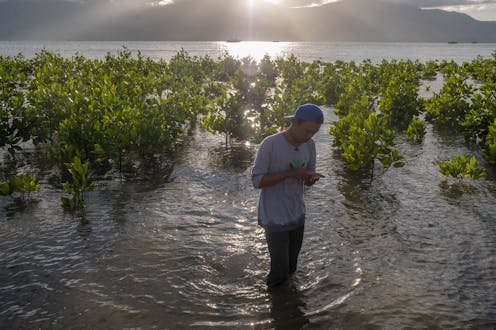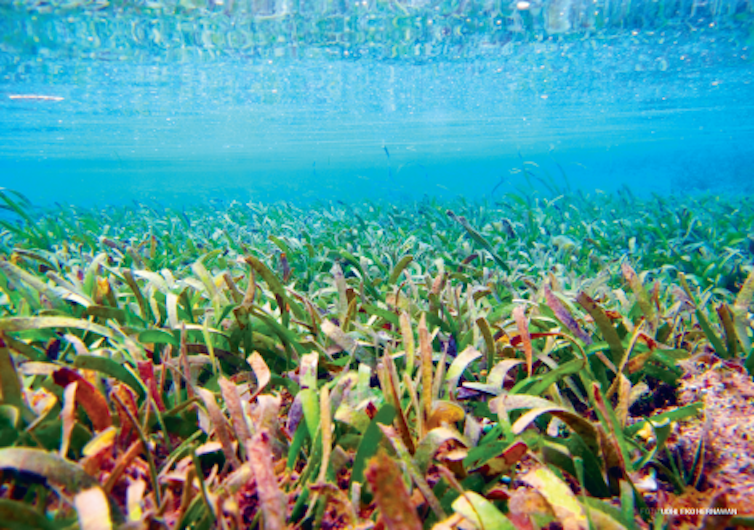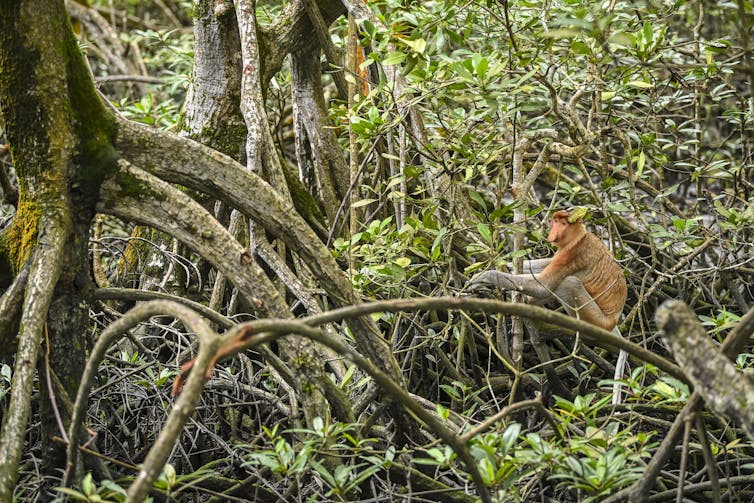
Indonesia’s mangroves and seagrass are one of the key to global climate mitigation efforts, as they store around 17% of the world’s “blue carbon”.
“Blue carbon” refers to marine and coastal ecosystems that absorb carbon from the atmosphere and store it in the ocean and its sediment.
However, mangrove and seagrass ecosystems in Indonesia are endangered due to conversion and degradation.
Failure to halt the conversion and degradation of these ecosystems will exacerbate climate change, as it will result in long-accumulated carbon and other greenhouse gases being released into the atmosphere.
Indonesia needs a sustainable source of funding to conserve and restore its blue carbon ecosystems, and carbon credits are one of the viable funding options.
Conservation and restoration projects on blue carbon ecosystem can actually generate money in the forms of carbon credits that can be sold to individuals or companies seeking to compensate their emissions.

To sell a carbon credit in a domestic market, a project needs to meet the standards set by the government. For global markets, a project should also follow the rules set by the government and standards created by an independent third party, such as Verified Carbon Standard (Verra) or Plan Vivo Foundation, and be registered in the National Registry.
Last year, Verra registered its first “blue carbon” conservation project, aiming to sequester almost one million tonnes of carbon dioxide over 30 years in coastal ecosystems in Colombia. Verra’s move into this type of project is expected to bring a stream of blue carbon credit investments and initiatives into Indonesia.
Indonesia is the world’s largest archipelagic state, with more than 18,000 islands. That means Indonesia has the potential to harness more carbon credits from its blue carbon ecosystems to support its conservation and restoration efforts.
We highlight two aspects that need to be addressed so Indonesia’s blue carbon credit can flourish.
Better regulation and cooperation to track carbon credits

The Presidential Regulation No. 98 of 2021 and The Ministerial Regulation No. 21 of 2022 serves as a legal basis for Indonesia’s carbon economy, but the authority responsible for blue carbon protection and restoration requires more detailed arrangement.
That regulation states that climate mitigation activities for blue carbon and marine sector fall under the authority of Ministry of Marine Affairs and Fisheries.
Yet mangroves, which are also part of the blue carbon ecosystem, fall under the Ministry of Environment and Forestry’s authority, as most mangroves in Indonesia are situated within the country’s forest areas.
Recently, both ministries have agreed to divide their responsibilities – Ministry of Marine Affairs will take care of mangroves outside of forest area.
Still, these two ministries need to sit together to agree on clear standards and procedures for managing mangroves to avoid regulatory overlap between ministries. This overlap can lead to an increase in expenses for future project developers, deterring potential investment. A strategic framework to coordinate different functions and roles of multiple agencies and local government could help to gain optimum benefits of Blue Carbon ecosystems.
Read more: Can blue carbon help Indonesia meets its 2030 emission targets?
In addition, data and information on Indonesia’s blue carbon ecosystems are scattered in various institutions, including the Ministry of Environment and Forestry, Ministry of Marine Affairs and Fisheries, the National Research and Innovation Agency, and regional governments.
Blue carbon research and data integration across institutions is essential to accelerate progress, since available and reliable data is crucial to set a baseline and target to properly measure the effectiveness of a carbon credit project. Indonesia’s mangrove emissions data has been documented, but much work is still needed for seagrass.
Non-governmental actors including environmental organisations, research institutions, and finance and business entities also play an essential role in blue carbon conservation and restoration. Proper coordination and collaboration between these actors could results in impactful blue carbon projects.
Community participation and benefit sharing

Carbon credits projects in coastal wetlands could generate revenue for climate financing and, if managed properly, could bring prosperity to coastal communities. Coastal communities are among the most vulnerable populations in Indonesia.
A 2016 research led by Lindsay Wylie from American University School of International Service has proven how strong community involvement can lead to successful blue carbon projects around the world.
For example, the community-led project “Mikoko Pamoja” has succeeded in restoring 117 hectares of a mangrove ecosystem in Gazi Bay, Kenya. The project has also generated income from its carbon credits. The money has been spent to build a school and install water pumps.
The Indonesian government can emulate these success stories by engaging with local communities in blue carbon conservation initiatives, because the sustainability of these projects will depend on coastal communities who directly benefit from it.
Read more: Gender matters in coastal livelihood programs in Indonesia
To do that, the government could establish and implement safeguards: a set of principles, rules and procedures designed to protect impacted communities against unwanted risks of the project, as well as to improve their wellbeing.
The project must also secure consent from the community before its implementation. Establishing a channel for the community to express concerns, submit their complaints regarding project implementation, as well as to pay more attention to gender issues, are also pivotal for the success of the projects.
Civil society organisations play a central role in building trust with the community in the implementation of blue carbon projects.
To ensure local community participation, projects must be creative to provide various forms of benefit-sharing.
For example, silvofishery – a combination of aquaculture and mangrove rehabilitation – can be a win-win option. This type of project allows local communities to obtain economic benefits while ensuring the health of mangrove ecosystems.
Some of the ideas in the article were developed during the IORA Indian Ocean Blue Carbon Hub's 2022 Early Career Visiting Professional Fellowship Program
Bimo Dwisatrio does not work, consult, own stock or receive funding from any company or organization that would profit from this article, and have disclosed that they have no affiliations other than the academic affiliations listed above.
Sandy Nofyanza does not work, consult, own stock or receive funding from any company or organization that would profit from this article, and have disclosed that they have no affiliations other than the academic affiliations listed above.
This article was originally published on The Conversation. Read the original article.







